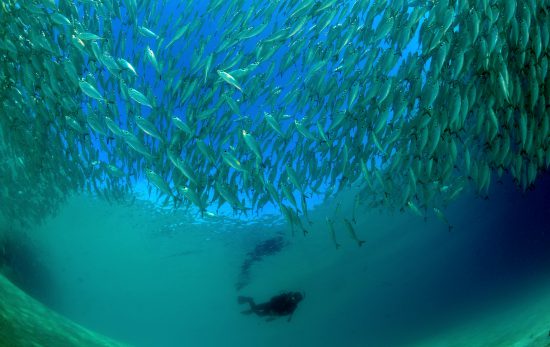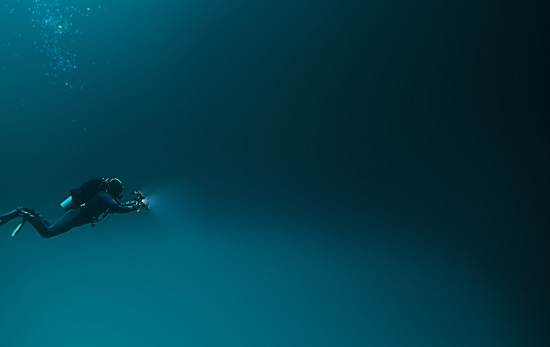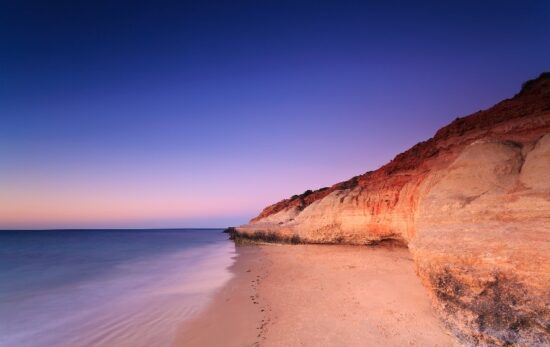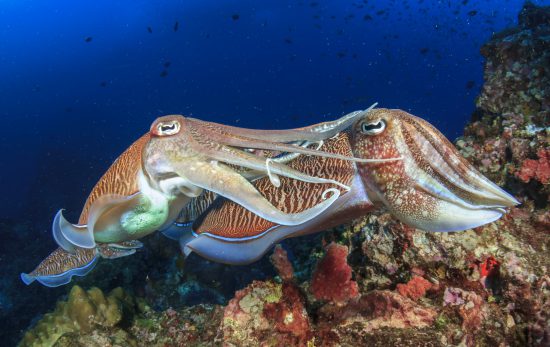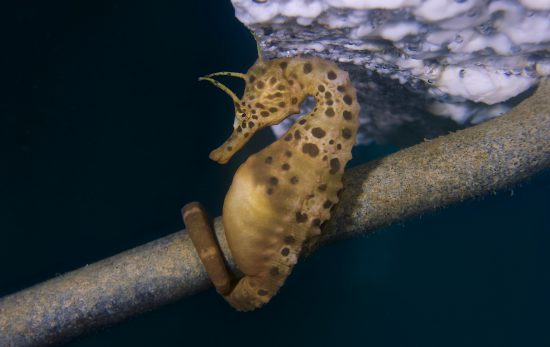All images provided by Ron van der Marel
Are you planning to dive in South Australia? Here are seven of the region’s best dive sites that you definitely don’t want to miss out on. So dive in and read on….
Edithburgh Jetty
Located around three hours west of Adelaide this is a shallow jetty dive site which is packed with a phenomenal amount of marine life. From nudibranchs, frogfish, eels and dumpling squid through to the iconic leafy sea dragon and seahorses, this is an underwater wonderland for photographers and marine life enthusiasts. For night divers, the list of species gets even longer as South Australia’s nocturnal critters put on a show, time and time again. For those who don’t shoot macro, the pylons are covered with sponges and soft corals which add a dash of vibrant colours, and make for stunning jetty-dive wide-angle photographs too.
Entry and Exits: Edithburgh Jetty is well set up for divers of all levels and you’ll find platforms and ladders for entry and exits.
PADI Courses: Digital Underwater Photography Specialty, Open Water Diver, Peak Performance Buoyancy Specialty, Night Diver Specialty.
When to Dive: It’s possible to dive Edithburgh Jetty all year round but water temperatures are warmest from October through to May.

Rapid Bay Jetty
One and a half hours south of Adelaide is Rapid Bay Jetty, one of South Australia’s most famous shore dives consisting of not one, but two jetties! Around each jetty structure you’ll find thriving marine ecosystems which are home to an assortment of critters and vibrant corals. Of course, one of the highlights of diving here is the chance to see the leafy sea dragon but one of the other draws of Rapid Bay is that there is so just so much to explore! On dive at Rapid Bay is just not enough, even though the site only reaches up to 10 meters/33 feet in depth. The old jetty pylons are beautifully overgrown with soft corals in a rainbow of colours. Common species at Rapid Bay include nudibranchs, (pygmy) leatherjackets, cowfish, and there are frequently large schools of fish. Look out for huge bull rays on the bottom!
Entry and Exits: There is a platform and stairs from the end of the new jetty and the old jetty is just a short swim away.
PADI Courses: Fish Identification, Open Water Diver, Peak Performance Buoyancy Specialty
When to Dive: It’s possible to dive Rapid Bay all year round. For warmer water temperatures it’s best to dive during the summer months (October to May).

Port Noarlunga Jetty (Aquatic Reserve)
This spectacular natural rocky reef dive incorporates both reef and a jetty – and it’s located just 40 minutes from Adelaide’s city centre.
With over 200 species of marine plants and animals, and over 73 types of fish, this is an excellent dive site for all levels of divers. The site has a maximum depth of around 18 meters/60 feet and showcases some of Australia’s most common and iconic species. Some of the most frequently spotted residents include moonlighter, zebrafish and common stingrays and if you like macro life, you will find hermit crabs, nudibranchs, seahorses, flatworms and pipefish. On good days you might also spot blue devil fish, wobbegongs, cuttlefish, Port Jackson sharks and occasionally a leafy sea dragon. Larger marine species occasionally frequent the area too, including passing dolphins and whales. Keep an eye out to the blue!
Entry and Exits: There are several entry and exit points including beach entries or a jetty and stairs leading directly to the water. There is around a 300 meter/984 feet walk from the parking area to the end of the jetty.
PADI Courses: Open Water Diver, Peak Performance Buoyancy Specialty, Underwater Naturalist Specialty.
When to Dive: The calmest dive conditions are around low tide, during high tides there can be strong currents. While it’s possible to dive here all year round, water temperatures are warmer from October to May.

The Bluff, Victor Harbour
If you are looking for incredible diversity then the Bluff is the place to be! This site is weather dependant but on a good day you’ll meet everything from sealions to sea dragons. Located one hour south of Adelaide, the site is scattered with large granite boulders, ledges, swim throughs and crevices – which are all well worth exploring. The site is home to a vast array of South Australia’s most common species and highlights including a variety of nudibranch, leafy sea dragons, seahorses, crayfish, playful sealions and you might even be lucky enough to spot a passing dolphin. Weedy sea dragons have also been spotted here but there are no guarantees.
Entry and Exits: There is more than one entry and exit point as the site can be dived from the shore (beach) or from the fishing jetty and ladder.
PADI Courses: Fish Identification, Digital Underwater Photography Specialty, Advanced Open Water Diver.
When to Dive: The Bluff can be dived all year round, however it is exposed to the south and can be prone to more challenging conditions.

Port Hughes Jetty
Located just one and half hours north-west of Adelaide, Port Hughes Jetty is a must for those with a passion for underwater photography. Pack your macro lenses and be prepared for non-stop shooting opportunities! Some of the stand-out critters here include frogfish, nudibranch, a wide variety of macro crustaceans, pygmy cuttlefish and dumpling squid. If macro isn’t your calling, then the vibrant, soft coral adorned jetty pylons provide for ample wide-angle opportunities and on a sunny day, the sun’s rays cutting through the water are simply stunning.
Entry and Exits: The main access point is down steps which lead directly to the water.
PADI Courses: Night Diver Specialty, Fish Identification, Digital Underwater Photography Specialty.
When to Dive: Port Hughes Jetty is an excellent year round dive. Warmer water in the summer months reaches around 20 degrees Celsius/68 degrees Fahrenheit (expect around 14 degrees Celsius/57.2 degrees Fahrenheit during the winter).

Star of Greece Wreck Dive
Built in 1868, the Star of Greece was a three-masted iron ship which sank in 1888. Over 125 years underwater has resulted in a multitude of marine life taking up residence and the wreck is now an abundant living reef. Take your time exploring the wreck, which starts in just 4 meters/13 feet of water. The wreck lays only 200 meters/656 feet from the shore and is actually visible from the surface at low tide.
The wreck and surrounding area are home to some of the more unusual species of nudibranch in South Australia. You can also expect to find large schools of small and juvenile fish around the wreck and a hoard of various crabs.
Entry and Exits: There are different entry points to the wreck depending on which side you approach from – all are beach entries.
PADI Courses: Wreck Diver Specialty, Peak Performance Buoyancy Specialty.
When to Dive: The wreck is best dived when the sea is flat and there is no or little swell. This is a shallow dive and when there is swell or surge, the sand is stirred up and visibility is significantly reduced.

The Norma Wreck
Located 40 minutes off shore, north of Glenelg, the Norma wreck lays in 15 meters/49 feet of water. The Norma was a cargo ship preparing to sail to Europe in 1907 when she was rammed by the Adencraig, the captain of which had misjudged the distance between the two vessels.
The wreck has numerous identifiable parts including her bow, masts, ribs, frame work and machinery. Take your time exploring and look out for macro-life which seeks shelter in the shaded areas. Fish life is abundant and highlight sightings here include wobbegong sharks, small schools of snapper, boarfish, bullseye, cuttlefish, old wives, nudibranch and numerous crustacean species.
Entry and Exits: The Norma is a boat dive in a shipping channel – using a delayed surface marker buoy is strongly recommended.
PADI Courses: Delayed Surface Marker Buoy (DSMB) Diver Specialty, Fish Identification, Wreck Diver Specialty, Peak Performance Buoyancy Specialty.
When to Dive: The Norma can be dived all year round but if you prefer warmer water, the wreck is best dived during the summer months from October to May.

We hope this selection of jetties, reefs and wrecks has inspired you to get suited up and dive into South Australia. Locate a local PADI dive shop and start your next underwater adventure today – happy diving!

